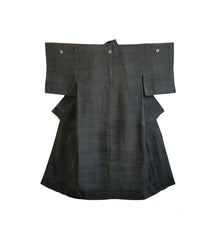A 19th Century Hemp Edo Komon Kimono: Small Figure Stencil Resist Dyed Kimono
ca. mid nineteenth century
57 1/2" x 23", 146 cm x 58.5 cm
This is an unlined kimono made of a very finely plied hemp or ramie (asa) fabric, dyed charcoal grey whose small, all over pattern is knows as Edo komon.
The salient feature of this kimono is the minuscule patterning all-over the kimono, which is characteristic of the late Edo Period (ca. 1830-60) and is called komon, which indicates an all over figured pattern.
In the case of this kimono, the pattern is that of very tiny maple leaves: quite marvelous to behold.
This incredibly small pattern is the result of an arduous resist dye technique called katazome. Rice paste is 'squeegeed' through an intricately cut stencil about 8" x 10" directly onto the fabric and this stencil is moved down the length of the fabric. The areas of cloth with the applied rice paste will resist dye and will remain undyed.
This kimono has a collar lining of blue silk. There is a fairly prominent insect hole on the proper, left front of the kimono, as well as on the silk patch on the seat, inside (see photo attached).
On the nape of the piece, and on the two sleeves on the back of the kimono is a resist dyed family crest in the form of two stylized pine branches.

